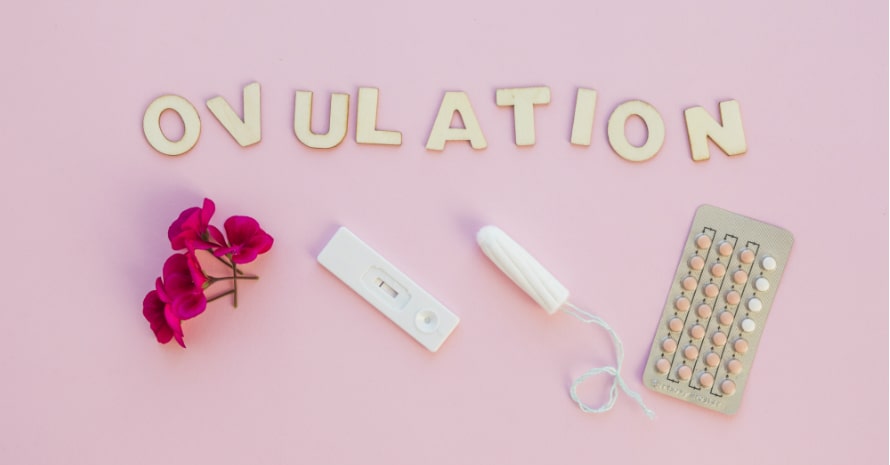What is Ovulation? Everything About Ovulation Days, Symptoms, and More

My name is Kiara Harris. It’s been already seven years since I started working as a kindergarten teacher. I enjoyed the miracle of birth and experience happiness of being a mother every day. Raising a daughter and working with children every day, I am happy to share my experience and useful information about kids. But today, I want to talk about a topic that interests most women who only plan to have a baby.
If you are thinking about conception, then knowing your body a little bit better is paramount to make this process fast and successful. In this article, you can find everything you should know about ovulation as this process is integral to women’s health and potential pregnancy.
Here is not just an ovulation definition but also tips on how to calculate it, how you can determine your ovulation day, as well as what are the main symptoms. Also, in the end, I provide answers on the most common questions about ovulation that lots of women struggle with.
Ovulation Definition
Let’s start with getting ovulation defined first. Ovulation is the process during a woman’s cycle when the mature egg gets released from the ovaries and now can be fertilized. How long does ovulation last? The fertilization can happen only between 12-24 hours, and this is the duration of ovulation.
During the ovulation, the egg released travels down to the Fallopian tubes, and if fertilized, it will be shortly implanted on the uterus walls. In case it didn’t happen, you get your next period to shed the thick tissue that covers your uterus.
From the scientific point of view, three hormones play a significant role in the release of the egg and ovulation. These are luteinizing hormone (LH), progesterone, and estrogen. If you’re wondering when does ovulation occur, generally, it happens approximately 14 days before your next period. It should help you with ovulation calculation, yet it cannot be completely precise.
back to menu ↑
The Most Common Signs of Ovulations
There can be multiple symptoms of ovulation. But by knowing the major ovulation signs, you will know when to predict ovulation. Hormonal changes affect all your body, so during the ovulation, you might experience such symptoms as breast tenderness, headache, ovulation cramping, etc.
It’s highly recommended to monitor, track, and record all symptoms you have during the ovulation to understand how your body behaves during these days. It will help you to detect abnormal signs and prevent health issues. Here is a list of the main symptoms that might occur:
Changes in Mucus
Your cervical mucus after ovulation, before, or during it will be different. Once the ovulation is coming, your body starts to produce more estrogen hormone that can cause some changes in the consistency of your cervical mucus. It will get the more clear egg-white look and become more stretchy. It’s intended to help sperm attain the released egg easier and faster. Thus, if mucus looks stretchy and sticky, then it probably means that you are in your fertile phase.
Ovulation Cramps
Cramping during ovulation can happen very often, same goes with cramping after ovulation. It’s a certain sign. This pain is also called mid-cycle pain, which you can experience from time to time. It feels dull and mild in the area of your lower abdomen.
However, not all women experience this kind of pain or feel it not every single month. It can last from a few minutes to a few hours. The cramps have to go away after one or two days. There is nothing to worry about, but if the pain gets more intense, you should consider seeing your physician or OB.
Acute Sense of Smell
If you feel that your sense of smell became sensitive in the middle of the cycle, this is also an ovulation sign. During the fertile period, the sense of smell gets more acute because women are supposed to feel androstenone, a male hormone.
Breast Tenderness
During the ovulation period, your breast or nipples can become sore or tender. Hormone activities in your body cause this sign during ovulation.
Spotting or Discharge
I should also mention that some women may have spotting during ovulation or mid-cycle ovulation bleeding that they might confuse with their period. Red or brown discharge or moderate spotting is not that common but absolutely normal. Bleeding during ovulation occurs when the follicle that surrounds an egg to protect it gets mature enough and ruptures, which causes bleeding. There has to be no room for concerns regarding this.
Increased Libido
It’s normal when your sexual desire becomes more intense during ovulation. It’s the natural way that spurs us to reproduce at the right time when your body is ready for conception.
Cervix Changes
It’s difficult to detect this symptom, but still, it’s possible. Cervix changes during ovulation and becomes softer, higher, and opens up. You can check it, but you have to know your body well enough to feel a distinct difference. An OB can check your cervix for changes and teach you how to do it at home.
back to menu ↑
How to Determine Your Ovulation
You can rely on the list of signs of ovulation or check your ovulation calendar daily to catch the right day. Also, you may consider using that ovulation calculator girl from work has recommended you. It is even possible to detect the right time by monitoring the consistency of your ovulation discharge.
However, if you’re taking the conception really seriously, I would recommend you to use ovulation predictors or ovulation tester. These tools will help you detect the day precisely and answer the question “When will I ovulation?”. So, here are all the main ways to determine it:
Monitor Your Basal Body Temperature (BBT)
Simply put, it is the temperature of your body while being at rest. Your body temperature at the beginning of your menstrual cycle is consistent enough with an average of 97.2 – 97.6 degrees Fahrenheit. Once your ovulation is coming, the temperature decreases slightly, and right after it, the temperature will increase by 0.4 to 1 degree.
The only way you can learn when ovulation occurs based on BBT is months of monitoring. You should use a digital thermometer for this purpose, which is designed to measure BBT. Finding one won’t be a problem as you can buy it in the closest drugstore or order it online. Right after you wake up, measure your BBT, and put it down to track it from day by day.
Remember that temperature can fluctuate so you have to wait for a significant rise that will point you on these days. After a few months of monitoring, you will be able to understand when you are ovulating to plan conception.
Check Your Menstrual Chart
This variant is very simple and doesn’t require any expenses. You can track your ovulation by recording when your period begins and ends for months. In case you have a normal menstrual cycle which varies from 25 up to 35 days, you’re supposed to get ovulation regularly. It has to happen 14 days before you have your next period.
As I have mentioned before, you should write down all the symptoms that you get during your fertile window and ovulation day. Write down every single detail such as mood swings, breast soreness, mucus consistency to understand how your body behaves and predict ovulation more precisely.
Use Ovulation Predictor Kits and Ovulation Testing
An ovulation predictor kit is a great way that will significantly facilitate your life. If you don’t want to waste your time measuring your BBT, checking your cervix or mucus consistency, this tool delivers fast and accurate results. An ovulation test will help you predict the upcoming ovulation 12-24 hours in advance.
It simply measures the level of luteinizing hormone or LH. Your body gets the highest level of this hormone right before your ovulation starts. LH can be determined in your urine. All you have to do is to pee on a stick and wait for a few minutes. If the indicator color matches with the one mentioned in instructions, this means that you are about to ovulate within 24 hours.
If the color is different, make this test one more time. Ovulation kits are quite easy in use, and there are five sticks that you can use for a few days in a row. Be careful with their expiration date though. Otherwise, you will get wrong results. Also, take into consideration that it’s recommended to take the test in the morning for the majority of ovulation predictors.
To achieve the most accurate results, take the test at the same time each day, and reduce liquids night before to make the urine more concentrated. Therefore, it will be easier to measure LH level.
There is another way to identify the upcoming ovulation through a saliva test. It measures the estrogen level in your saliva. This test is reusable so that it can be much cheaper than the ordinary kit.
Consider Fertility Monitor
An ovulation kit is an effective solution, but it only determines the day when ovulation will occur. Respectively, you will have only one day for conception. A fertility monitor is a useful tool to identify the five most fertile days of your menstrual cycle. It measures the level of LH and estrogen and determines two main fertile days. Also, it helps you figure out from one to five days before or after the main ones that are also fertile and can be appropriate for conception. More advanced versions of fertility monitors can analyze the info from your previous cycles. Keep in mind that this option is quite pricey. It is more expensive than a first response ovulation test or clear blue ovulation test.
back to menu ↑
Things You Should Know About Your Ovulation Circle
Here are my answers to the most common questions a lot of women interested in. Keep this information in mind, and you won’t have to worry about your ovulation period a lot.
What Happens When I Ovulate?
If you keep wondering what does ovulation mean for your body, you have probably found the right answer here. In short, every month, a mature egg come out of your ovaries and then moves down your Fallopian tubes. If the egg is successfully fertilized, the lining of your uterus starts to thicken, so that a fertilized egg can settle in this lining. The egg survives only up to 24 hours, and if not fertilized, then your body sheds the thick lining of the uterus. This means your period starts.
What Are My Most Fertile Days?
The majority of women are usually the most fertile on the ovulation day itself and during five days before it. It’s better to use an ovulation calculator or ovulation tracker to stay on top of your women’s health and be as precise as possible. My days period and ovulation can also vary, so I always track it with my ovulation calender.
A lot of women don’t know their bodies well and, thus, wonder, “When do I ovulation?”. Ovulation days can vary, but generally, it happens 14 days before your next period. It’s difficult to predict the release of the egg, so to increase your chances for conception, you should have regular sex from 11th to 16th day of your period.
Can I Get Pregnant When I’m on My Period?
The chances of getting pregnant on your period are extremely low, though it’s still possible. It can happen in case you have a short or long period. Sperm stays alive in Fallopian tubes for up to 6 days. So, if you have sex, for instance, on the last day of your period, the sperm can survive and the egg released can get fertilized.
If you are off your birth control pills that you’ve been taking for a long period of time, you should give your body some time to get used and function without pills.
What Are My Chances of Getting Pregnant Each Month?
The overall chances of you getting pregnant highly depend on your age. It’s true that the younger you are, the higher chances are for you to conceive a baby. For women of 25 and younger, the chances of getting pregnant with every ovulation cycle are from 20 to 25 %. For women at the age of 30, the chance will drop, and you get only 15% to conceive monthly. At the age of 35, the likelihood of you conceiving will attain 10% only.
Is It Normal to Have Ovulation Pain?
Mid-Cycle pain is one of the most common ovulation symptoms that might occur. It’s quite normal to experience ovulation pains that can be characterized as dull or sharp ache. The pain ovulation can last from a couple of minutes up to 24 hours.
Generally, it’s quite mild, so you have nothing to worry about. Just treat it with any pain relievers you can get from your drugstore. If painful ovulation has more intense character, then it’s worth seeing your physician.
back to menu ↑
Few Remarks for Last
I decided to write on this topic as many women don’t know when is ovulation in the cycle. I hope that I gave you the maximum of useful information about ovulation. The aim of the ovulation process is the only one – to help you get pregnant. Without it, the conception would be impossible at all.
Understanding this process better by knowing how to detect your fertility window and when is ovulation occurring can help you in getting pregnant. By learning ovulation symptoms, signs, and knowing the ways to calculate fertile days, you will increase your chances of conceiving a baby. Try always to stay on top of your calendar, measure your temperature, put down all changes in your cycle.
Remember that systems of ovulation are complex, and even young women have only 20-25% chances of getting pregnant each month during ovulation. By implementing the information described above, you will be able to get higher chances to detect ovulation and respectively get pregnant.
If you have some cycle disorders, hormonal disbalance it all can slow down the process. In such cases, consult with your doctor to keep health under control and get closer to the dream of becoming a parent. Kids are the flowers of our lives, and they are worth all our efforts.
Have you already been using some ways of determining your ovulation? What options do you find the most useful? Leave a comment below and share your experience with me!








Hi there! Would you mind if I share your blog with my twitter group?
There’s a lot of people that I think would really appreciate your content.
Please let me know. Thank you
Of course. We really want every girl to have the opportunity learn such important things about herself and a possible pregnancy.
Good day! This is my first comment here so I just wanted to
give a quick shout out and say I truly enjoy reading through your
posts.
Many thanks!
Thanks, Lora. This is the best reward for us.
I could not resist commenting. Perfectly written thoughts about ovulation!